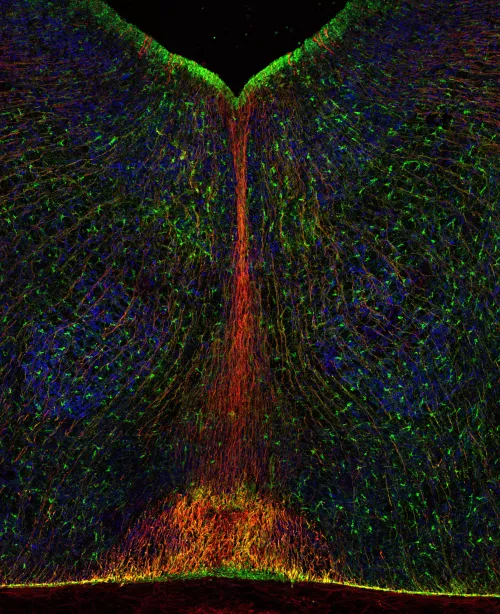DNA contains the instructions for cells to make RNA transcripts, many of which are then translated into proteins. But with only two percent of the human genome encoding proteins, scientists do not understand what many of the other thousands of RNA molecules in cells do.
Daniel Lim, MD, PhD, a professor in the Department of Neurological Surgery at UC San Francisco, studies a type of large RNA molecule called long noncoding RNA (lncRNA). His research into figuring out which lncRNAs influence neural development – with new funding from a National Institutes of Health (NIH) Research Project grant – could help scientists understand how these processes might go wrong in neurological diseases and brain cancer.
Lim’s lab has, for several years, focused on Pkny – a lncRNA that the researchers identified as having an important role in regulating the birth of new neurons. Their experiments showed that Pkny binds a protein called PTBP1, and together, they stop neural stem cells from the producing neurons.

Their studies indicate that Pkny works inside the nucleus of some neural stem cells to change the abundance of other RNA transcripts, but the researchers do not know how exactly this process occurs.
Lim thinks that the structure of the RNA molecule holds the key to its functions in brain development. “I grew up in a household of engineers and architects,” Lim said, “so I still see biology as a form of architecture.”
In collaboration with Anna Pyle, PhD, and her team at Yale University, Lim’s research group is now testing how Pkny’s three-dimensional molecular structure affects its interaction with PTBP1 and its role in stem cells.
“Most people have been studying lncRNAs as being functional but have very little understanding about how they work,” Lim said. “This work is unique in that it's pushing the boundaries of understanding structure and function of these RNA molecules.”
Lim is also interested in how lncRNAs as a group modulate neural development. He and his colleagues previously showed that many lncRNAs are present at high levels in specific types of neural stem cells in the developing brain, suggesting that these molecules may help the cells in establishing their identity.
Lim’s research team is now looking into how lncRNAs regulate neural induction, the earliest stage of brain development when stem cells first receive signals to become neurons. The scientists are conducting a big, unbiased CRISPR screen of many lncRNA and all the coding genes in stem cells to test which ones are important in the process.
By performing these experiments in brain organoids, Lim says his team can learn how lncRNAs and coding genes function together in the developing human brain.
The NIH does not usually fund exploratory research, so Lim says the initial support from the Hana Jabsheh Research Initiative was critical to fostering new collaborations and proving his lab’s expertise with genomic screening methods.
For example, he and his colleagues found that hundreds of lncRNAs might be important for cell growth. More recently, the researchers identified a lncRNA that could serve as a potential target to increase the sensitivity of glioma cells to radiation therapy.
“I don't think we really appreciated how much noncoding RNA is inside of a cell until RNA sequencing technologies became common,” Lim said.
Lim says his studies will help scientists figure out whether coding genes and lncRNAs serve distinct functions in cells as they develop into young neurons.
